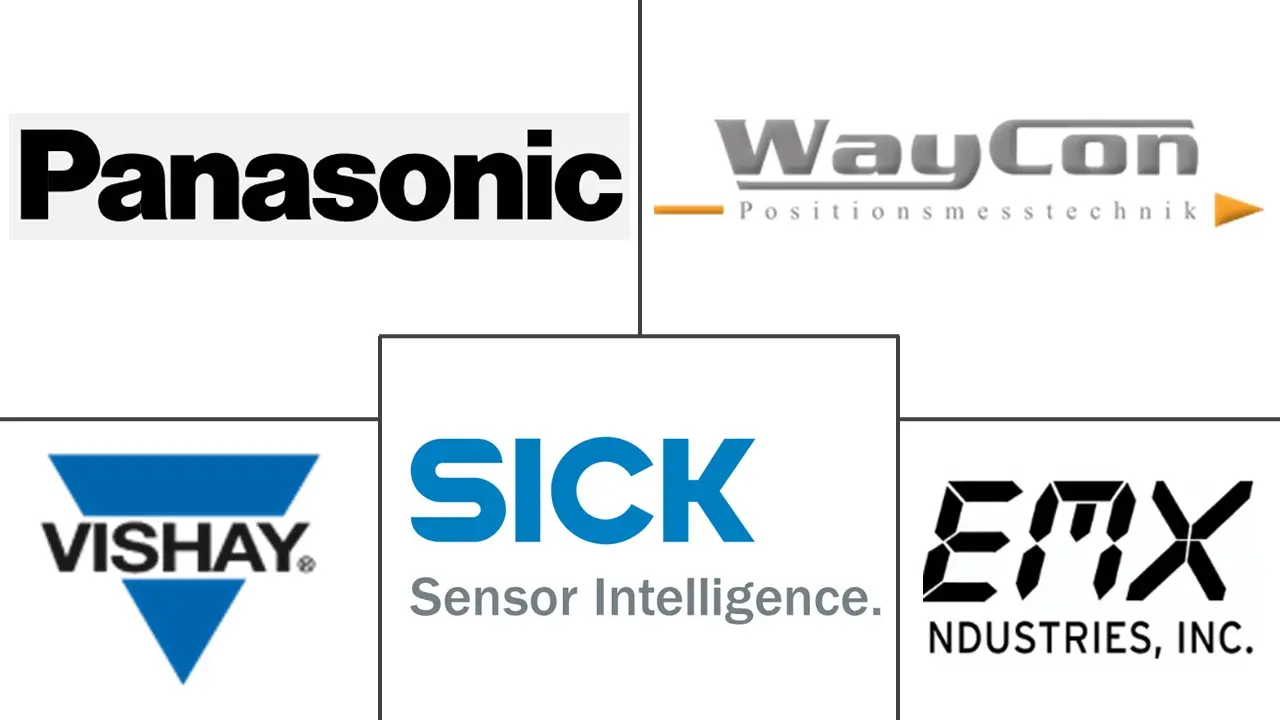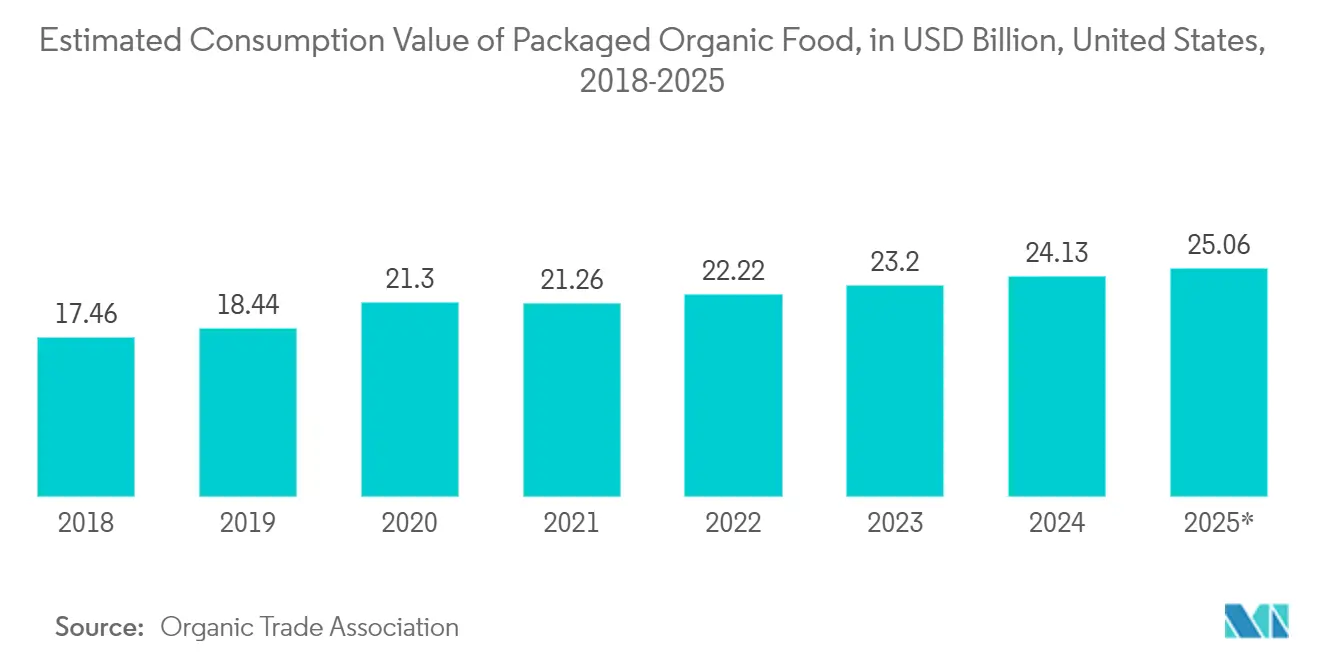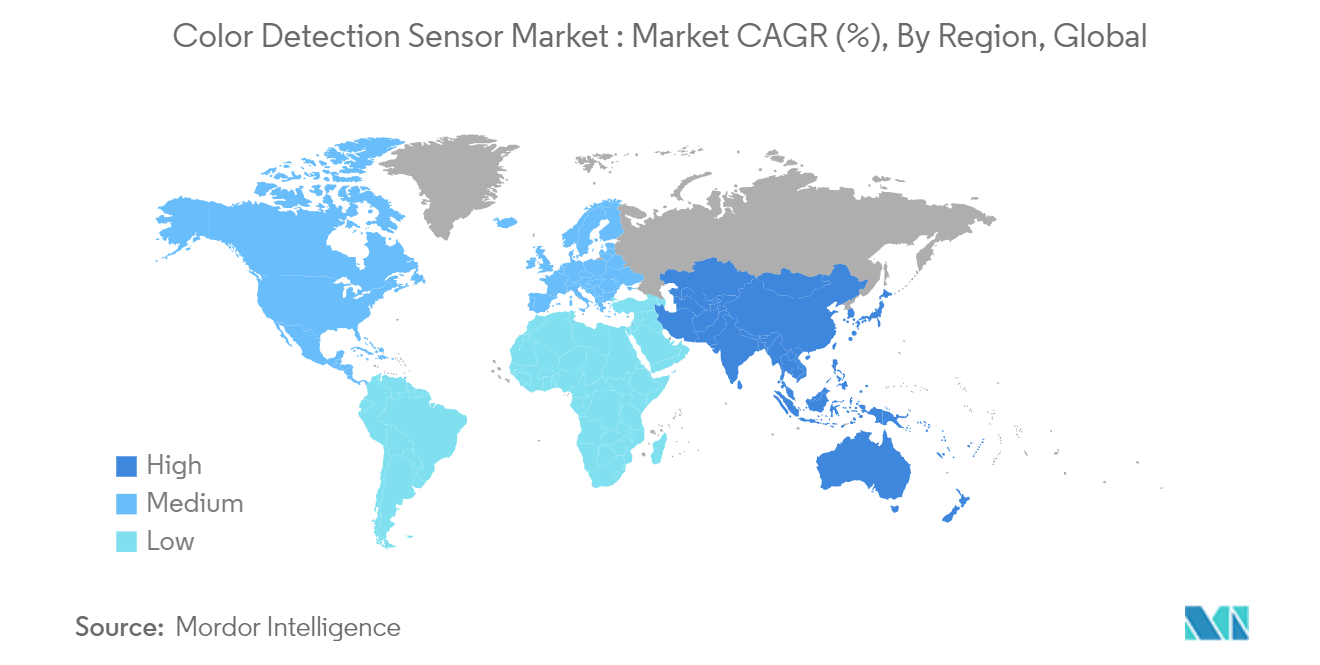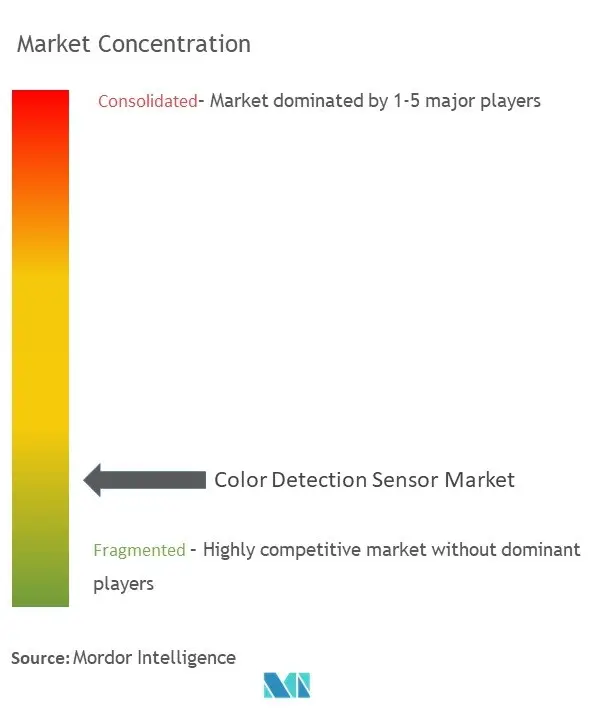Color Detection Sensor Market Analysis
The Colour Detection Sensor Market size is estimated at USD 1.61 billion in 2025, and is expected to reach USD 2.27 billion by 2030, at a CAGR of 7.18% during the forecast period (2025-2030).
Color detection sensors emit light onto objects and measure the direct reflection or the output. Many of these sensors come equipped with integral light sources, ensuring they achieve the desired effect. These sensors are pivotal in grading-colored products, distinguishing coded markings, and verifying the presence of adhesive or data codes on packages. Their primary applications include true color recognition and color mark detection. Sensors designed for true color recognition must differentiate between colors or shades, often operating in sorting or matching modes.
- Color sensors, utilizing diffuse technology, have been developed to detect a broad spectrum of colors. These sensors employ a combination of color-sensitive filters and an array of sensors to conduct color sensing. This data then analyzes the colors in an image or a specified object. The color measurement process typically involves a light source that illuminates the target surface and a receiver that captures and measures the reflected wavelengths.
- The integration of color sensors in smartphones significantly influences the growth of color detection sensors. Smartphone color sensors distinguish between natural and artificial light, enhancing the functionality of optical lenses in these devices. Integrating color sensors with IoT and AI technologies allows for real-time data analysis and decision-making, further improving their applications.
- Color detection sensors play a crucial role in industries like textiles, ensuring color consistency in production, and are a staple in industrial automation setups. Industries spanning food and beverages, commercial and consumer printing, consumer electronics, automotive, pharmaceuticals, healthcare, and chemicals use these sensors increasingly to identify even the subtlest color variations.
- The high initial costs are one factor restricting the growth of the color detection market. While color detection sensors offer numerous benefits, including ensuring quality control and consistency during manufacturing processes and enhancing accuracy and reliability in color detection, their cost can be a barrier to adoption.
Color Detection Sensor Market Trends
Food and Beverage Industry to be the Fastest Growing End User
- In the food and beverage industry, color and appearance are pivotal for a product's success. Consequently, the demand for color detection sensors has surged, from raw materials to the final product. This technology, known for its high precision, enables users to assess color attributes across various samples, from solids and liquids to powders and granules.
- By swiftly pinpointing any inconsistencies, companies meet color quality standards and streamline processes, reducing waste and boosting profits. Implementing these sensors ensures that the final product consistently meets the desired visual standards, crucial for maintaining brand reputation and customer satisfaction.
- Ingredients are crucial, not just for taste and texture, but also for adding visually appealing colors to food products. Given the diverse chemical properties of ingredients like grains, powders, sugar, and cocoa, each necessitates a tailored testing approach. Food processing units, recognizing the significance of ingredient color, opt for highly standardized methods to ensure the final product's color quality. These methods involve using advanced color measurement devices that may accurately detect even the slightest variations in color, ensuring that the end product is visually consistent and appealing to consumers. This meticulous attention to color quality is essential for meeting regulatory standards and consumer expectations.
- In the food and beverage industry, these sensors are instrumental in monitoring safety and quality control in meat production. With stringent regulations and heightened food and beverage packaging demands, color detection sensors, especially in color mark and registration applications, have become indispensable.
- Packaged food consumption across different countries is also a major factor supporting the market's growth. For instance, according to the Organic Trade Association, the consumption of packaged organic foods has been growing globally. In the United States, the annual consumption value is anticipated to reach USD 25.06 billion in 2025 from USD 17.46 billion in 2018.
Asia-Pacific Expected to Witness Major Growth
- Owning its expertise in the technology-driven sectors, the United States dominates the market. According to the International Trade Administration, the United States is the primary producer of equipment for industrial automation globally, including hardware and the components used for the industrial and manufacturing settings to automate systems.
- The ongoing expenditure for industries like automotive, oil and gas, and power is increasing the demand for industrial automation and boosting the market associated with automation, including the market of color detection sensors.
- The significant rise in sales of smart color cameras and smart color sensors has progressed significantly in the United States over the past several years. With the smart color sensor, this technology has made massive gains. It provides a more excellent color resolution. Many manufacturers also offer versions of these sensors that may give calibrated RGB color results.
- The solid presence of the market's leading players in the United States and the continuous development of color sensors by these top players play a significant role in the market. For instance, Rockwell continuously improves its sensors portfolio by innovating smart sensors offered by the company. Its photoelectric sensors are recognized as the most robust in industrial automation.
Color Detection Sensor Industry Overview
The color detection sensor market is fragmented due to low entry barriers. Some key players in the market are SICK AG, EMX Industries Inc., Wenglor Sensoric GmbH, Vishay Intertechnology Inc., and Panasonic Corporation.
- In November 2023, SICK Ag unveiled a significant enhancement to its color sensor lineup, debuting the CSS and CSX models known for their high resolution and speed. The CSS, SICK's latest flagship, stands out for its unparalleled color resolution, excelling in discerning even the most subtle shade variations. Its prowess in recognizing nuanced surface textures broadens its potential applications.
- In October 2023, Balluff GmbH opened its new production facility in Aguascalientes, Mexico, enabling the sensor and automation specialist to achieve its planned growth while creating resilient supply chains. The new site would help the company supply its customers in the Americas region with locally produced products with high availability and short delivery times.
Color Detection Sensor Market Leaders
-
SICK AG
-
EMX Industries Inc.
-
Wenglor Sensoric GmbH
-
Vishay Intertechnology, Inc.
-
Panasonic Corporation
- *Disclaimer: Major Players sorted in no particular order
Color Detection Sensor Market News
- May 2024: Leopard Imaging Inc. announced the stereo camera EAGLE 2 LI-VB1940-GM2A-119H launch at Embedded Vision Summit 2024. The camera marked a significant milestone in vision technology. It introduces the world's first RGB-IR high-resolution stereo camera with patent-pending features, poised to redefine day and night vision capabilities. The Eagle 2 camera boasts an advanced design, incorporating two automotive-grade 5.1-megapixel shutter RGB-IR image sensors.
- January 2024: Chemistry and Environmental Science researchers at the University of Birmingham, in partnership with scientists from the German Federal Institute for Materials Research and Testing (BAM), pioneered an innovative method to detect 'forever chemicals' in water using luminescence sensors.
Color Detection Sensor Industry Segmentation
A color detection sensor detects the material's colors, primarily in the RBG scale. These sensors detect the color with the help of a light source that illuminates the material surface. A surface whose color has to be detected is required, and then a receiver measures the reflected wavelengths to give the result of the detected color. These sensors are applied to measure and detect the color of various surfaces. These sensors have multiple applications, including industrial, medical, automotive, etc. There are different types of color detection sensors, such as brightness, contrast, luminescence, RGB, and print mark sensors.
The color detection sensor market is segmented by type (brightness sensor, molecular luminescence sensor, RGB sensor, and print mark sensor), end-user industry (food and beverage, healthcare, chemical, textile, automotive, consumer electronics, and other end-user industries), and geography (North America, Europe, Asia, Australia and New Zealand, Latin America, and Middle East & Africa). The report offers the market size in value terms in USD for all the abovementioned segments.
| By Type | Brightness Sensor |
| Molecular Luminescence Sensor | |
| RGB Sensor | |
| Printed Mark Sensor | |
| By End-user Industry | Food and Beverage |
| Healthcare | |
| Chemical | |
| Textile | |
| Automotive | |
| Consumer Electronics | |
| Other End-user Industries | |
| By Geography*** | North America |
| Europe | |
| Asia | |
| Australia and New Zealand | |
| Latin America | |
| Middle East and Africa |
Colour Detection Sensor Market Research Faqs
How big is the Colour Detection Sensor Market?
The Colour Detection Sensor Market size is expected to reach USD 1.61 billion in 2025 and grow at a CAGR of 7.18% to reach USD 2.27 billion by 2030.
What is the current Colour Detection Sensor Market size?
In 2025, the Colour Detection Sensor Market size is expected to reach USD 1.61 billion.
Who are the key players in Colour Detection Sensor Market?
SICK AG, EMX Industries Inc., Wenglor Sensoric GmbH, Vishay Intertechnology, Inc. and Panasonic Corporation are the major companies operating in the Colour Detection Sensor Market.
Which is the fastest growing region in Colour Detection Sensor Market?
Asia Pacific is estimated to grow at the highest CAGR over the forecast period (2025-2030).
Which region has the biggest share in Colour Detection Sensor Market?
In 2025, the North America accounts for the largest market share in Colour Detection Sensor Market.
What years does this Colour Detection Sensor Market cover, and what was the market size in 2024?
In 2024, the Colour Detection Sensor Market size was estimated at USD 1.49 billion. The report covers the Colour Detection Sensor Market historical market size for years: 2019, 2020, 2021, 2022, 2023 and 2024. The report also forecasts the Colour Detection Sensor Market size for years: 2025, 2026, 2027, 2028, 2029 and 2030.
Our Best Selling Reports
Colour Detection Sensor Industry Report
Statistics for the 2025 Colour Detection Sensor market share, size and revenue growth rate, created by Mordor Intelligence™ Industry Reports. Colour Detection Sensor analysis includes a market forecast outlook for 2025 to 2030 and historical overview. Get a sample of this industry analysis as a free report PDF download.







